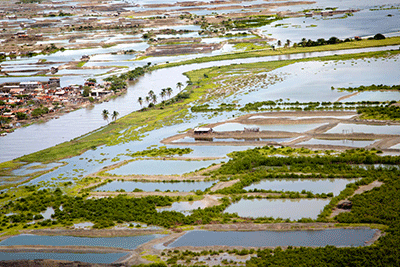Goal 13: Take urgent action to combat climate change and its impacts
Climate change is already having a profound and alarming impact worldwide. Global temperatures continued to increase in 2016, setting a new record of about 1.1 degrees Celsius above the pre-industrial period. The extent of global sea ice fell to 4.14 million square kilometres in 2016, the second lowest on record. Atmospheric CO2 levels reached 400 parts per million. Drought conditions predominated across much of the globe, influenced by the El Niño phenomenon. In addition to rising sea levels and global temperatures, extreme weather events are becoming more common and natural habitats such as coral reefs are declining. These changes affect people everywhere, but disproportionately harm the poorest and the most vulnerable. Concerted action is urgently needed to stem climate change and strengthen resilience to pervasive and ever-increasing climate-related hazards.

Photo Credit : © UN Photo/UNICEF/Marco Dormino
Countries’ commitment to taking climate action is gaining momentum, as indicated by the early entry into force of the Paris Agreement
The landmark Paris Agreement brings nations together to strengthen the response to climate change. It aims to keep the global temperature rise this century to well below 2 degrees Celsius above pre-industrial levels and as close as possible to 1.5 degrees, while building countries’ resilience to the adverse effects of climate change. The Agreement entered into force on 4 November 2016, marking a shift in focus towards implementation. It also signals the commitment of nations to take action for the climate and sustainable development, translating the goals of the Paris Agreement into actionable strategies and shifting global financial flows onto lowcarbon, climate-resilient pathways. As of 7 June 2017, 148 parties had ratified the Paris Agreement. In parallel with the Agreement, a push to develop and implement initiatives to enhance financial flows, technologies and capacity-building efforts to support developing and most vulnerable countries is underway.
Parties to the Paris Agreement are expected to prepare, communicate and maintain successive nationally determined contributions (NDCs). NDCs highlight climate-related targets, policies and actions planned in response to climate change. Countries’ NDCs relayed so far reveal linkages across all SDGs. They outline development approaches and actions aimed at lowering greenhouse gas emissions and building climate resilience. The NDCs show that governments are integrating climate action into socio-economic development strategies, since both are integral to sustainable development. As of 7 June 2017, 142 Parties (141 countries plus the European Commission) had communicated their first NDCs to the United Nations Framework Convention on Climate Change Secretariat (UNFCCC).
Countries are preparing and implementing national plans to adapt to climate change and enhance resilience
The national adaptation plan (NAP) process is designed to help developing countries identify their medium- and long-term needs for adaptation to the effects of climate change, and to formulate and implement strategies and programmes to address those needs. It is a continuous, progressive and iterative process with a country-driven, gender-sensitive, participatory and fully transparent approach. Implementation helps countries reduce their vulnerability to the impacts of climate change by building adaptive capacity and resilience, and by integrating climate change adaptation into development planning processes and strategies. As of 7 June 2017, seven countries had completed and submitted the first iteration of their NAP; the process in many other countries is under way. Progress is expected to accelerate with support from the Green Climate Fund, which is mandated to provide expedited support to LDCs and other developing countries in the formulation and implementation of NAPs.
Disaster risk reduction has the potential to reduce the rising toll of human lives from smaller-scale events
Between 1990 and 2015, more than 1.6 million people died in internationally reported natural hazards, and the trend is moving upward. Since mortality is often concentrated in very intensive disasters, it is difficult to perceive trends over relatively short periods of time. However, data on smaller-scale disasters show a statistically significant trend towards increasing mortality in events with fewer than 100 deaths. A similar study taking into consideration population growth also showed an upward trend. Disaster mortality reflects not only exposure to hazards, but also a confluence of other vulnerability factors, such as poor urban management, environmental degradation, lack of disaster preparedness, and poverty and inequality. Moreover, these underlying risk factors are responsible for most morbidity resulting from natural hazards, and tend to affect low-income households and communities and small businesses disproportionally. The data suggest that an increased focus on disaster risk reduction is a prudent investment for saving lives.
Disaster risks are magnified by poverty, inequality, environmental degradation and poor urban planning
Reducing risks associated with natural hazards requires a comprehensive approach that prevents new risk, minimizes existing risk, and strengthens economic, social, health and environmental resilience. Over the last decade, countries have made progress in managing the worst impacts of disasters, mainly by developing institutions and policies for disaster risk reduction and strengthening capacity for disaster preparedness, response and early warning. That said, progress has been limited in tackling the underlying drivers of disaster risk—poverty, poor urban planning and land use, weak environmental and resource management, and climate change. Countries have thus begun implementing national and local disaster risk reduction strategies that also address these risk factors. Of 96 countries that reported data, all used environmental impact assessments as a mechanism to address such factors. However, only 51 countries used payment for ecosystem services as a mechanism, which is known to promote better land management and the protection of ecological services.

Number of Parties that have ratified the Paris Agreement, number of Parties that have submitted NDCs and total number of Parties to the UNFCCC, June 2017